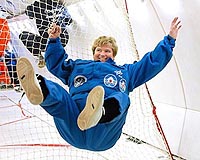 |
Cape Canaveral, Florida (AFP) Feb 22, 2010 After finding a break in the rainy weather at two US landing sites, the shuttle Endeavour descended to a landing in Florida late Sunday to end a two-week mission that pushed the long-running assembly of the International Space Station close to completion. The shuttle's high-speed glide to Earth ended with a touchdown at NASA's Kennedy Space in Florida at 10:20 pm EST (0320 GMT Monday). Endeavour's successful delivery of Tranquility, the final US habitable module, leaves NASA with four more shuttle missions to finish the station's outfitting. The last of the flights, set for late September, will bring a 12-year effort by the United States, Russia, Europe, Japan and Canada to a close. "Congratulations on a great mission," Mission Control radioed the six astronauts as the shuttle rolled to a stop. "It's great to be home," said Endeavour commander George Zamka. "It was a great adventure." The forecast for rain showers and low clouds at both Kennedy and the shuttle's backup runway at Edwards Air Force Base, California, seemed to offer little hope of a landing on Sunday. But Norm Knight, the NASA flight director who supervised Endeavour's landing from Mission Control, urged his team to put aside thoughts of the gloomy forecast, recalling successful landings when the outlook was just as bleak. After installing Tranquility, the shuttle astronauts worked with the five astronauts on the station to equip the new module with critical life support systems, exercise equipment and a roomy observation deck. They also revived the station's water recycler. The system that recovers drinking water from urine and moisture in the breathing air is a crucial part of plans to keep the station staffed with a half-dozen astronauts when the shuttle is no longer available to deliver supplies. The new observation dome surrounds a control post for a robot arm that will play a crucial role in the docking of the commercial capsules that NASA expects to take over the cargo deliveries. The roomy dome also offers those living aboard the station unprecedented views of the Earth below. "Arguably, mankind has been after this view for centuries, this perspective, this view of the world," said Zamka after his crew completed the Tranquility's installation with three spacewalks. "We finally have it, and we will take advantage and enjoy it." US President Barack Obama doted over the new Earthly panoramas from the observation deck when he spoke with Zamka and his shuttle colleagues, Terry Virts, Steve Robinson, Kay Hire, Bob Behnken and Nicolas Patrick. The latest additions pushed the station's mass beyond one million pounds, or 98 percent of the final weight, and go 90 percent of the volume anticipated at the end of assembly. "It's an amazing facility, and it's very rewarding for all of us to be here at this stage, as we transition from assembly to full utilization," said NASA astronaut Jeff Williams, the station's current commander. "We all look forward to reaping the benefit of the utilization over the next 10 years or so." Just days before Endeavour's departure, Obama presented Congress with a plan to overhaul NASA, including the controversial cancellation of the agency's Constellation lunar exploration program. The overhaul includes plans to extend station operations through at least 2020, a four-year extension that was quickly endorsed by NASA's international partners. Early Sunday, the station's command and control computers experienced a series interruptions. The episode left leaving Williams' crew temporarily unable to communicate with Mission Control, a reminder of the station's isolation. The problem seemed to be resolved Sunday afternoon, but the cause of the difficulties had not been clearly identified. The station's life support systems were not affected.
Share This Article With Planet Earth
Related Links Space Tourism, Space Transport and Space Exploration News
 SwRI Announces Pioneering Program To Fly Next-Gen Suborbital Experiments With Crew
SwRI Announces Pioneering Program To Fly Next-Gen Suborbital Experiments With CrewBoulder CO (SPX) Feb 22, 2010 Southwest Research Institute announces a new initiative to build and fly experiments with SwRI payload specialists on next-generation suborbital vehicles. The program, supported with a $1 million allocation from SwRI, will be led by Dr. Alan Stern, associate vice president of the SwRI Space Science and Engineering Division. It is the first program of its kind in the nation. "We are strong ... read more |
|
| The content herein, unless otherwise known to be public domain, are Copyright 1995-2010 - SpaceDaily. AFP and UPI Wire Stories are copyright Agence France-Presse and United Press International. ESA Portal Reports are copyright European Space Agency. All NASA sourced material is public domain. Additional copyrights may apply in whole or part to other bona fide parties. Advertising does not imply endorsement,agreement or approval of any opinions, statements or information provided by SpaceDaily on any Web page published or hosted by SpaceDaily. Privacy Statement |